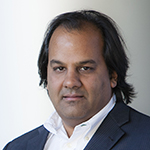June 2015

Atul Malhotra, MD
It is a great honor to be addressing the ATS membership in my first presidential message, and I would like to take this opportunity to describe the focus of my 2015-16 term: the next generation. For me, the decision to concentrate the Society’s efforts on early career professionals is easy. What success I have had professionally has been largely attributable to the younger people around me. The proverb “it takes a village” can be directly applied to my labs at the University of California, San Diego, and Harvard Medical School, respectively, as I have been blessed with countless amazing trainees, technicians, students, colleagues, and mentors.
Although we have had a productive laboratory that has made important scientific progress, my biggest source of pride is the steady stream of independent scientists who have emerged from it. I feel the same way on the clinical side, particularly when I see former trainees who have exceeded expectations and who have made major contributions to medical education and patient care.
While I have been fortunate, I find the lack of talented young people entering our field alarming. I was particularly struck by this when I attended my nephew’s graduation at Stanford University and met several talented young people. After speaking with them, I was disappointed to learn that essentially none was going into medicine. Some were going into business. Others were doing exciting things with computer and information technology. Others were getting advanced degrees. But I struggled to find any of the “best and brightest” who wanted to heal the sick, to teach our students, and/or to cure disease. I remember thinking, “Where are our replacements?”
Finding an answer to that question will form the centerpiece of my presidency.
Over time, I have committed to using my position within the ATS to help address the issue of our intellectual pipeline, and I am not alone in this endeavor. With the help of many colleagues, we have created programs including the Student Scholars Program, the ATS Resident Boot Camp (many thanks to Dr. Laura Crotty Alexander!), the Fellows Track Symposium, and the ATS Global Scholars Program.
The Students Scholars Program, which launched at the ATS 2013 International Conference in Philadelphia, invited local medical students to experience the conference and gain a better understanding of the pulmonary, critical care, sleep medicine. As a direct result of this experience, more than 50 percent of participants expressed an interest in joining our field. We have since broadened the program to include not just medical students but also graduate students, nursing students, Master of Public Health students, respiratory therapists, and others.
The Resident Boot Camp invites medical residents who have been accepted into fellowship training to learn the essentials of our field in a coordinated but exciting environment at our International Conference. The program has been a major success, doubling in size to accommodate 140 residents since its initiation at ATS 2014. This has generated considerable enthusiasm and, hopefully, many lifelong ATS members.
My predecessor, ATS Immediate Past President Tom Ferkol, MD, created the ATS Academy, which recognizes scientists, educators, and clinicians who have done well and hold promise to be leaders in the years to come. Patricia Finn, MD, a former ATS president, conceived of the Lung Corps as a way to recognize “do-gooders” focused on respiratory disease.
One of the cornerstones of my presidency will be launching the Global Scholars Program. This initiative will address the shortage of advanced training programs in respiratory disease in nations in Africa, Latin America, and Asia by offering a series of web-based educational sessions using webinar technology to provide interactive lectures on a regular basis. Pre- and post-tests will be offered, and young doctors who successfully complete the program will receive ATS Global Scholars certificates. You will be hearing more about this initiative throughout the year.
All of our ATS programs have one common goal: to attract and retain young people in our field through recognition, peer support, and creating a mindset that if we all work together, we can make a difference. During the next year, I look forward to working with my colleagues in the ATS and our sister societies to help expand global expertise in respiratory, critical care, and sleep medicine.

